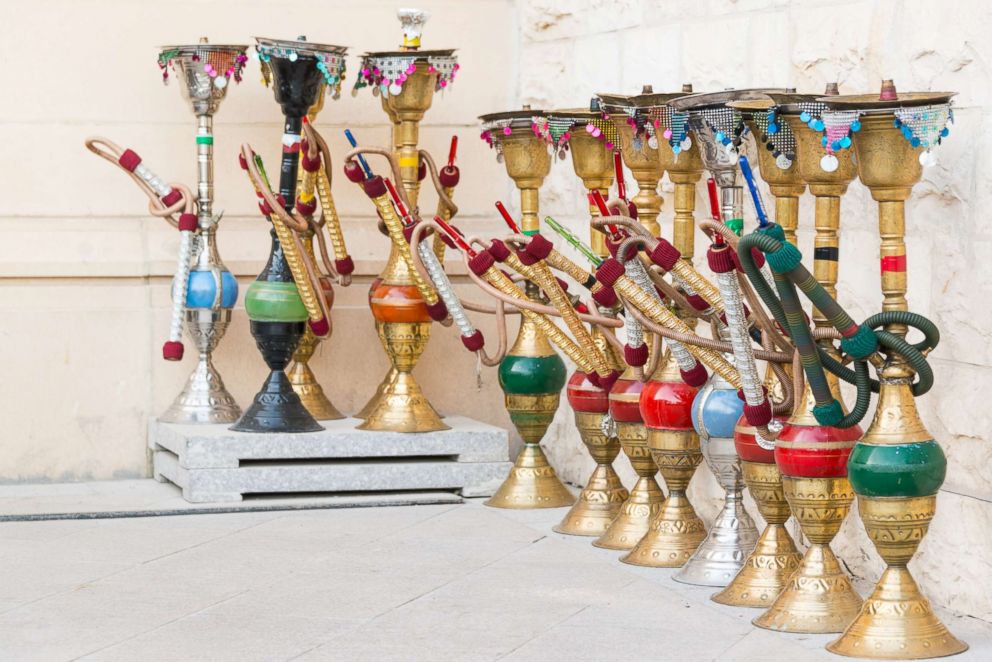Young American smokers get half of their smoke through hookahs: Study
Researchers surveyed more than 3,300 American adults aged 18 to 30.
Over half of the tobacco smoke consumed by young American smokers is inhaled through hookahs, and more must be done to specifically curb this kind of smoking, a new study published in the British Medical Journal Thursday found.
In the study, researchers surveyed more than 3,300 American adults aged 18 to 30 and asked them how frequently and how much hookah smoking -- also known as waterpipe tobacco smoking -- and regular cigarette smoking they did in March and April of 2013.
Researchers then used statistical analysis to estimate the proportion of toxicants originating from each kind of smoking. They found 55 percent of the volume of smoke inhaled by the people surveyed came from hookah smoking.
Ahead, here's what to know about the risks of the craze.
What is hookah smoking?
Hookah smoking, also known as waterpipe tobacco smoking, started out in India and the Eastern Mediterranean Region, but hookah parlors have gained popularity across the U.S. The practice is especially popular among young American adults -- 5 percent to 10 of young adults reported smoking hookah in the past 30 days, according to the article published in the British Medical Journal. An even larger percentage -- 20 percent to 30 percent -- have taken at least a puff in the past year.
Like cigarette smoking, the tobacco is still burned, but is instead drawn out of the hookah through water. Hookah smoke is thought by many to be somehow cleaner and less irritating when compared with cigarette smoking, but it has the significant risks.

Is tobacco smoked through a hookah safer than cigarettes?
"The vast majority of time, the stuff that is placed in the hookah is called shisha. It is a mixture of tobacco, flavoring, sweetener, and other chemicals. Some people put other things in the head of the hookah, such as marijuana. However, for this particular study, we made it very clear that we were only interested in them telling us how much hookah they used specifically with tobacco," Dr. Brian Primack, professor of Medicine and Pediatrics at the University of Pittsburg and a lead author of the study, told ABC News.
But consider this: smoking a cigarette takes a few minutes, and hookah sessions last longer. A 45-minute hookah session is associated with higher levels of toxicants, including tar, carbon monoxide and nicotine. And an hour of hooking smoking is one hundred to two hundred times the smoke volume inhaled from a cigarette.
Smoking studies have found that consuming one cigarette usually involves 10 to 12 puffs of about 50 milliliters of smoke each. On the other hand, one 45-minute to hour-long hookah session can involve up to 100 inhalations, and a total of about 500 milliliters of smoke consumed per person. The amount of smoke in a hookah session is definitely concerning, but because the smoke is less concentrated than smoke from a cigarette, it is hard to draw a direct comparison.
"I don't think there is an easy answer as to what is 'safer,'" Primack said. "Using either one has been associated with things like heart disease and lung cancer. However, we don't have enough data to make a direct comparison. Part of this is because hookah use is a relatively newer phenomenon, especially in the United States."
"If a person decides one night to either smoke one standard hookah session or one standard cigarette, this study shows that they would be getting a lot more smoke volume, carbon monoxide, tar, and even nicotine if they choose the hookah," Primack added.
Does hookah smoking contain fewer contaminants than cigarettes?
Primack said he and his team were "surprised at the sheer volume of smoke, tar, and other toxins to which hookah smokers are exposed."
"This is especially concerning because hookah is often perceived by youth as a harmless alternative to cigarette smoking," he added.
The study found that cigarette smoking did have more concentrated contaminants. The proportion of tar attributed to hookah smoking, for instance, was 21 percent, carbon monoxide was 10 percent, and nicotine was 2.4 percent. This shows that hookah smoking does deliver a slightly "cleaner" version of tobacco smoke.
But while the amount of amount of nicotine coming from the hookah was lower than that from cigarettes, even small amounts of nicotine have been linked to addiction in young people.
In fact, the initial use of hookah has been associated with people going on to try cigarettes, researchers found. These findings suggest that smoking prevention programs need to pay attention to hookah smoking as well.
What should be done to prevent young people from hookah smoking?
Ideally, there would be more studies that look at the long=term risks of hookah smoking, Primack said, but “we already have many studies that associate hookah smoking with large toxin loads and major clinical problems like heart disease and cancer"
He added that additional studies "could take years or even decades, and by that time many people will have lost their lives unnecessarily."
Policy reform will be crucial. There are already national laws that ban the flavoring of cigarettes, but these laws do not ban flavoring shisha (the form of tobacco used in hookah).
Shisha currently comes in chocolate, watermelon and cotton candy flavors.
The FDA recently finalized a rule to regulate waterpipe tobacco smoke, there are no plans to change policy regarding flavoring.
With all the strides that have been to discourage young people from smoking cigarettes, it’s time, researchers say, to turn some of the attention to the smoke from the local hookah parlor as well.
Sunny Intwala, M.D., is a third-year Cardiology fellow affiliated with Boston University School of Medicine and a clinical exercise physiologist who works in the ABC News Medical Unit.




